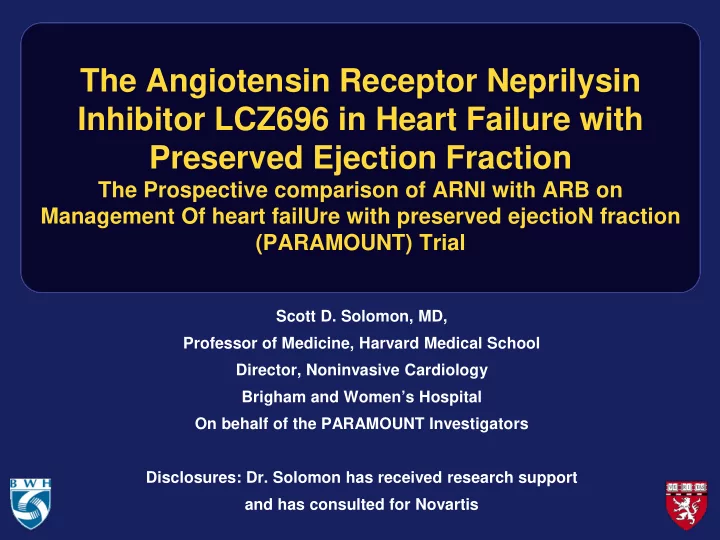

The Angiotensin Receptor Neprilysin Inhibitor LCZ696 in Heart Failure with Preserved Ejection Fraction The Prospective comparison of ARNI with ARB on Management Of heart failUre with preserved ejectioN fraction (PARAMOUNT) Trial Scott D. Solomon, MD, Professor of Medicine, Harvard Medical School Director, Noninvasive Cardiology Brigham and Women’s Hospital On behalf of the PARAMOUNT Investigators Disclosures: Dr. Solomon has received research support and has consulted for Novartis
Background • Heart failure with preserved ejection fraction (HFpEF) accounts for up to half of heart failure cases, and is associated with substantial morbidity and mortality, yet no therapies have been shown to improve clinical outcomes in this condition. • LCZ696 is a first-in-class angiotensin receptor neprilysin inhibitor that comprises the molecular moieties of a neprilysin inhibitor and the angiotensin receptor blocker (ARB) valsartan as a single compound. • As such, this compound simultaneously inhibits the renin-angiotensin- aldosterone system and augments the endogenous natriuretic peptide system, both of which may offer benefits in patients with heart failure. This drug is currently being tested in an 8000 patient reduced ejection fraction heart failure trial. • The PARAMOUNT trial was designed to test the safety and efficacy of LCZ696 in patients with HFpEF.
PARAMOUNT: Study Design LCZ696 LCZ696 LCZ696 200 mg BID 50 mg BID 100 mg BID Placebo run-in Valsartan Valsartan Discontinue ACEI or Valsartan 160 mg BID 40 mg BID 80 mg BID ARB therapy one day prior to randomization Prior ACEi/ARB use discontinued Week -2 0 1 2 4 8 12 18 24 30 36 Visit 1 2 3 4 5 6 7 8 9 10 11 6 month extension 2 weeks 1 week 1 week 10 weeks M & F > 40, NYHA II-IV HF, LVEF ≥ 45%, NT Population -proBNP > 400 pg/ml Primary NT pro-BNP reduction from baseline at 12 weeks (core study) objective Echocardiographic measures of diastolic function, left atrial size, LV size and function, PASP Secondary HF symptoms, Clinical composite assessment and Quality of life (KCCQ) objectives Safety and tolerability Baseline randomization visit and visit at end of 12 weeks of core study Clinicaltrials.gov NCT00887588
Change in NT-proBNP at 12 and 36 weeks 1000 900 Valsartan 800 NTproBNP (pg/ml) 700 600 p = 0.063 500 p = 0.20 p = 0.005 400 LCZ696 300 N=301 N=261 N=241 200 0 5 10 15 20 25 30 35 40 Weeks Post Randomization
Key Secondary Endpoints Left Atrial Volume NYHA Class Worsened 12 Weeks 36 Weeks Unchanged 2 Change in Left Atrial Volume (ml) Improved 110 1 P = 0.11 P = 0.05 100 0 Percent of Patients 90 80 -1 70 -2 60 50 -3 40 30 -4 20 -5 10 P = 0.18 P = 0.003 0 -6 LCZ696 Valsartan LCZ696 Valsartan Week 12 Week 36 LCZ696 Valsartan No Significant Changes in LV volumes, Ejection Fraction, or LV mass at 12 or 36 weeks
Conclusions • The angiotensin receptor neprilysin inhibitor LCZ696 reduced NT- proBNP to a greater extent than valsartan after 12 weeks of therapy, in association with reduction in left atrial size and improvement in NYHA class. These are all measures that have been associated with worse prognosis in patients with HFpEF. • Overall LCZ696 was well tolerated with fewer serious and overall adverse events than the comparator valsartan. • We consider these findings hypothesis generating, but they suggest that LCZ696 may have beneficial effects in patients with HFpEF and that further testing of this compound may be warranted in patients with this condition. Published simultaneously online in The Lancet
Recommend
More recommend